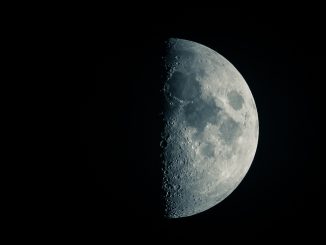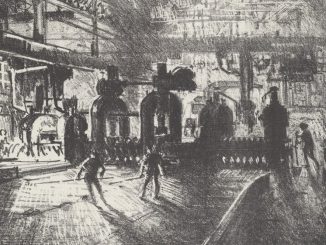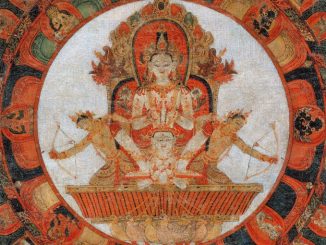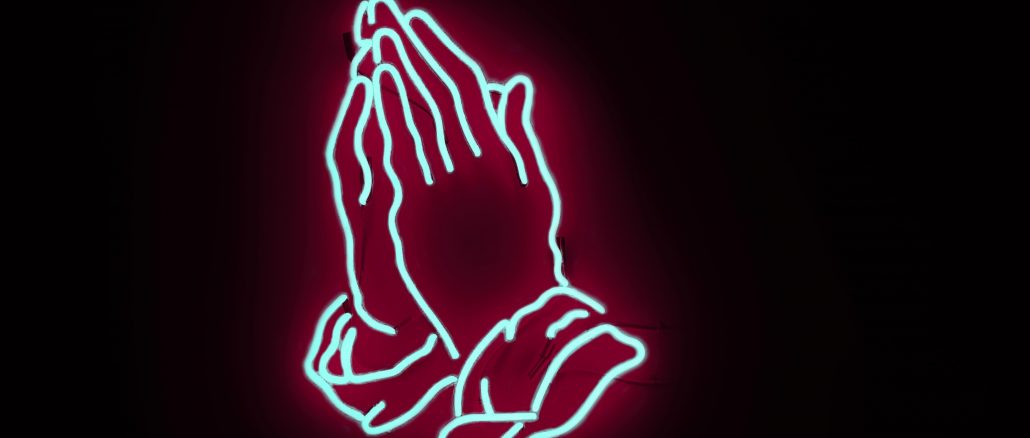
A reflection of Catholicism and Tarot/light occult beliefs; how they intertwine and connect despite being taught they were opposites, and how those teachings affected the writer as an adult.
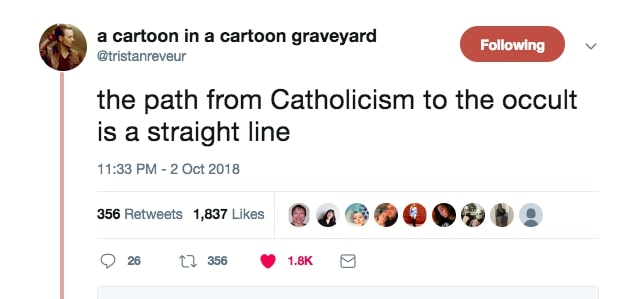
The moon had broken through, just so, turning the long white clouds that stretched to the horizon into a protective cocoon over the earth. They ran parallel to each other in thin lines until they didn’t, attached down the center, and for a wild moment it was as if I was seeing out past the bones of a ribcage. Perhaps the universe was different than we had been taught, perhaps the Earth was the heart muscle of a great sky being. The moon dipped back behind the cloud and I shivered. Does the heart know it’s part of a body? Can it understand how important it is to keeping the whole thing alive?
I fight against the idea that a full moon affects humans, that a grumpy day out of sorts can be predicted by an inanimate form in the sky. Yet I enjoy the balance of the waves, called to the shoreline by the very same moon. The thought that the two are connected seems meaningful to me, reassuring somehow. Humans are made almost entirely of water; our tears, our sweat, our blood all should follow the same call as our seas. But to recognize that I can be affected or controlled by something in the heavens is to admit things I no longer believe. I once tugged on the merciless collar of my grade school uniform during School Mass, spending most of the homily imagining grand, secular adventures and pausing only to admire the Mary statue. She seemed like a much more interesting person than St. Joseph or St. Francis. Always in blue, with flowing brown hair, her feet crushing a snake; she was exactly the type of character that populated my adventures. Had she been listed with Artemis, Athena, and Aphrodite I may have appreciated her ideology more, but the same church that covered itself in dramatic gold leaf and royal purple had a way of removing the life, the humanity from its stories. My favorite part was turning the pages in the Bible; they were so thin, so fragile, so dangerous. I wondered if ripping a page accidentally sent you to Hell; if the teachers would think you did it on purpose and accuse you of heresy. They should have accused me of witchcraft as I dug my nails into the back of my hands and prayed the other kids would just go away so I could finish my stories in peace. We had legends older than the countries we lived in, but spent most of Mass in a familiar workout routine. Three sets of kneeling, four rotations of prayers, another kneel and a handshake and back to Math class, amen. We were bored by overfamiliarity, rote recitation, and forced superstition. Yet a man was raising a glass filled with blood to the sky, intoning for a great power to fill us with his light. In a book I wrote, it would have been a villain ministering to his cult. But how could I notice the dramatics when I was so bored. They lulled me to sleep with heavy incense while I twisted glass beads around my wrist. No teachers ever mentioned crosses could be used to ward off vampires. Only at night when the room closed in did I truly believe, but then I prayed Hail Marys, because I assumed as the only human around she understood what it meant to be afraid of the dark. Jesus had known he was meant to die from his first day among us; how could I relate to that when I just wanted to live? It was only later I wondered if our teachers had skipped covering the Oregon Trail to avoid the Donner party. After all, we were eating flesh too.
It was not until much later did I learn Catholics were considered a cult, unChristian. We did not seem like an othered, marginalized minority. Christians were the default, and having been taught I was among them, I never thought that was not a universal opinion. The differences in denominations—who was eating what—did not seem very big and insurmountable to me. Surely we all knew we weren’t really eating Jesus; I mean, not like that. It was just a symbol, but through God a miracle had occurred and made it true, and the cognitive dissonance couldn’t catch up to me if I wholeheartedly believed in both. It was how ghosts were among us and did not exist at the same time. Satan was a metaphor, but a mental illness too—of all the things they taught us exorcism was not one. We signed purity pledges under our teachers’ watchful eyes and knew not to mess with sinful things like tarot or ouija board. If they weren’t real, powerless when God existed, why did we fear them? My stomach dipped in fear when I saw a pentagram, even though I had been taught they were the mistaken beliefs of the unsaved, searching for a meaning I was lucky enough to know. I felt as though I did not know enough, I wanted to know more. I wanted to see Mary in her blue veil and bohemian skirts have as much power as the men who had decided she was involved, without ever seeming to stop and think about how it would affect her. Long after I gave up the hope God was real, I continued to chant the familiar words in my head behind the wheel. Mother of God, pray for us. I did not think God could be real, but the extra precautions wouldn’t hurt.
Tarot was everything Catholicism was, but I appreciated it in the way I couldn’t remember to practice my Catholicism. Even some of the rituals were the same. There was a calming that started in my chest and worked its way down to my belly when I spread the simple cotton cloth out; the blue shade I loved so much because I had seen it so often in paintings of the Virgin’s veil. As an altar girl I was responsible for folding a white cloth for the priest to wipe his hands on; the only difference between why I loved one and hated the other was that I had chosen to. My cards were filled with Celtic legends, Arthurian references, Welsh and Scottish histories as old as the verses we read at the pulpit. Each had been cherished, passed down orally before committed to heavy tomes that landed on tables with satisfying thuds. The decorative borders were as lovingly drawn as the oversized letters that started paragraphs in my Bible, but they seemed so much more wholesome and appealing. I did not feel oppressed from the weight of history in my cards, but inspired. I wanted to be a part of their stories. The statues in church seemed to stare directly, so that I could feel them in the back of my neck, running down my spine. I carefully lined up clear crystals to protect me from bad energies and unknowns, forgetting the soapy white candles that had once touched my neck as we prayed for a Saint to save us from sore throats. There was always salt in a jar to soak up any metaphysical effects from reading and cleanse the room. I liked to shake it, listen to the sound, reassure myself it was all there, where it was supposed to be, and in the echoes of the noise I could hear the clang of heavy incense holders, the pungent aroma choking me, sending tears to my eyes. Catholicism seemed cruel and cold when I reached for my inhaler, but when I knocked three times on my cards I felt free and clear-headed.
I wanted to believe Tarot was real because I didn’t want to believe in Catholicism anymore. But when the cards told futures I didn’t like, I laughed it off as a meaningless amusement I’d chosen for myself—a way of rebellion, just pretty pictures about a cherished subject. I could not be sure they were real, as I had once questioned the existence of God, and eventually I wrapped up my deck and set it aside. I wanted tangibles I could hold in my hand, the blood of Christ, the thick cardstock of Llewellyn, amen.
I missed Church; not Mass, not my religion, but the place. There was a stillness and solemnity inside that inspired battles in faraway fields and heroines standing proudly at the front of ships, sailing for adventures. The quiet solitude allowed my imagination to speak. That was what sent me reaching under my bed for the box of pretty junk I kept stored there. The crystals were just crystals, but they sparkled like stained glass. My cards had paintings of pretty women, some wearing hooded robes as if they too could bear Christ, and when I sat with them I could look around and think about my life. I was guessing at meanings and foretellings, but I was attempting to make an educated guess, to think back over my day and construct a plot accordingly. Tarot was the reflection I had taught myself at Mass with the autonomy and control I required as a woman. The two should not have seemed so incompatible. I rapped on the deck and thanked whoever was listening for allowing me a moment of peace. I did not practice witchcraft or offer the last boneless wing to Hestia; I only shuffled a deck and felt a little thrill when a card would drop, clearly wanting to be seen and heard. Witches cast spells and drank blood as they turned from God. They had trained us to believe on faith and the similarity passed by unnoticed, that as we chanted in Latin to look out for us and not be too hard on us we sacrificed in a covenant as well. There is nothing wrong with the idea of Catholicism; that prayers are a request, not a spell, not an incantation. We perform no summonings; the Holy Spirit may be better understood as the shared humanity and morality all true Christians are assumed to share; assuming we need something bigger than us, that humans cannot just be good at their core. We are flawed, but the best of us—compassion, faith, love, belief, charity, hope—does not come from our religion. It is what makes our religion possible. When performed correctly, a Tarot reading or a Mass is a beautiful thing. I spread the cards lovingly, enjoying the feel of my personalized deck in my hands. It is warm to my touch, just basic body chemistry, but it makes it feel as though I am connected to it. I used to cup my hands, right over left to make a throne, to receive Holy Communion. It was not warm then, but it seemed to change in my mouth, just basic mental activity, but it made me feel as though it was real and valuable and I was lucky to be aware of the feeling. I would return to the pew and clasp my hands together and even though I could not understand what for, I felt thankful anyway.
In that moment, I wondered if it was God I saw, if he had stopped being mysterious for a moment and dropped his guard, ribs exposed. We are taught he lives inside of us, and I wondered if perhaps we lived inside of him. Maybe each planet was a cell of his body and it could all coexist peacefully. But we don’t teach our blood cells to worship us. We go about our lives, assuming they are there and looking after us, not quite understanding entirely how, but believing on faith. Catholic God is a trilogy, I spread my cards past, present, and future, and the only connection I can truly see is the way the waves ebb and flow to the full moon.
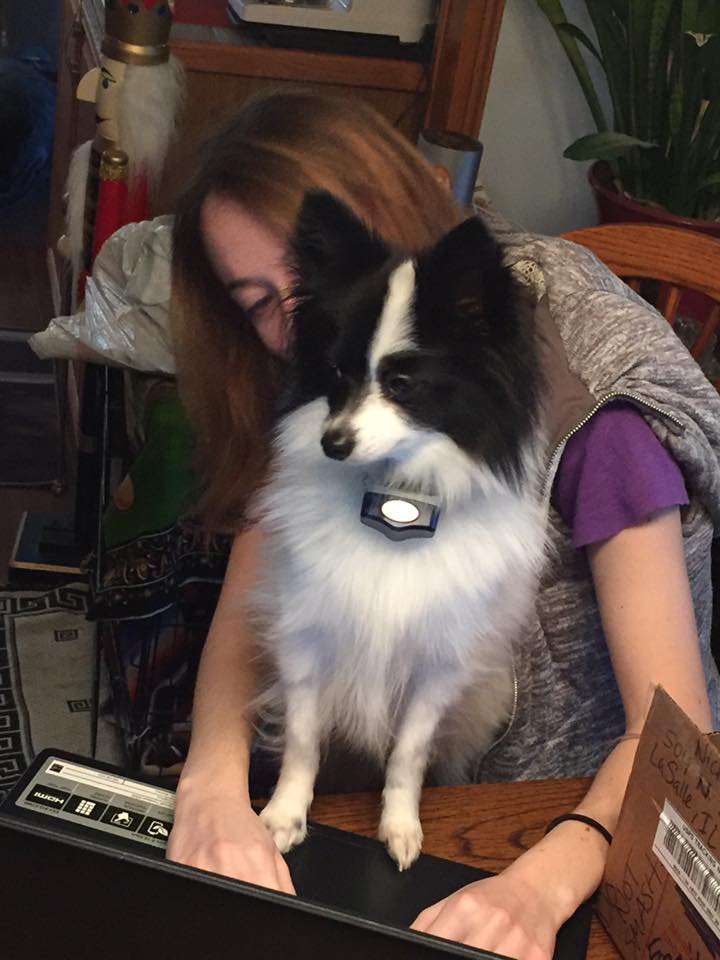
ANNA KAYE-ROGERS is an essayist in the Illinois Valley. Her favorite pieces have been published with HCE Review, The Stirling Spoon, Cosmonauts Avenue, and The Eastern Iowa Review. When she’s not writing she tries to avoid asthma attacks by napping. She can be found on Twitter and Facebook: @annakayerogers
Featured image: Photograph by Chris Liverani in Unsplash.
